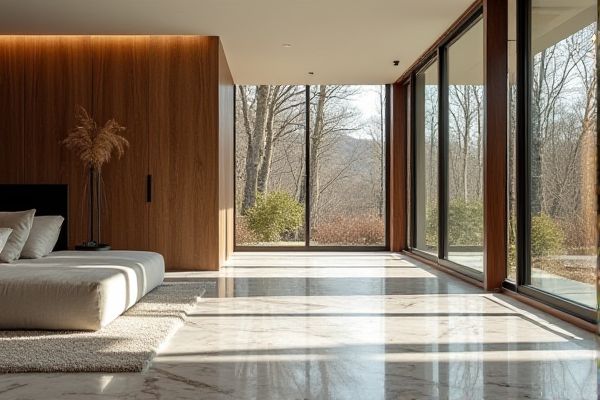
Gravel flooring offers a natural, porous surface ideal for outdoor areas, providing excellent drainage and a rustic aesthetic, while tiled flooring delivers durability, easy maintenance, and a sleek, polished look perfect for indoor spaces. Discover which flooring option best suits your needs and lifestyle by exploring the detailed comparison ahead.
Table of Comparison
| Feature | Gravel Flooring | Tiled Flooring |
|---|---|---|
| Material | Small loose stones or pebbles | Ceramic, porcelain, or natural stone tiles |
| Installation | Easy, requires minimal tools | Complex, needs adhesive and grout |
| Durability | Moderate, can shift or scatter | High, resistant to wear and impact |
| Maintenance | Low, requires occasional leveling | Moderate, cleaning and grout care |
| Comfort | Uneven surface, less comfortable | Smooth, comfortable to walk on |
| Cost | Low to moderate | Moderate to high |
| Appearance | Natural, rustic look | Varied designs, polished finish |
| Best Use | Outdoor areas, garden paths | Indoor floors, bathrooms, kitchens |
Introduction to Gravel Flooring vs Tiled Flooring
Gravel flooring offers a natural, permeable surface that enhances drainage and provides a rustic aesthetic, ideal for outdoor spaces and garden pathways. Tiled flooring delivers a durable, smooth finish with diverse design options, making it suitable for both indoor and outdoor environments that require easy maintenance and a polished look. The choice between gravel and tile depends on factors such as location, functionality, budget, and desired visual impact.
Material Composition: Gravel vs Tile
Gravel flooring consists of loose, naturally occurring stones that provide a porous and textured surface ideal for outdoor or rustic settings, offering excellent drainage and a more organic aesthetic. Tiled flooring is made from materials such as ceramic, porcelain, or natural stone, which are shaped and baked for a smooth, durable, and uniform surface suitable for indoor use with high resistance to moisture and wear. The inherent properties of gravel emphasize permeability and natural irregularity, whereas tile flooring focuses on structural integrity, ease of cleaning, and decorative versatility.
Aesthetic Appeal and Design Options
Gravel flooring offers a natural, rustic aesthetic with varied textures and earth tones that create a unique, organic look, perfect for outdoor spaces or casual indoor areas. Tiled flooring provides a wide range of design options, including colors, patterns, and finishes, allowing for precise customization to match any decor style from modern to classic. Your choice depends on whether you prioritize the tactile, informal charm of gravel or the polished, versatile elegance that tiles deliver.
Installation Process and Complexity
Gravel flooring installation involves laying a stable base layer of compacted soil or sand, then spreading and leveling the gravel, making it a relatively quick and low-complexity process suitable for DIY projects. Tiled flooring requires precise surface preparation, including moisture barriers and even subflooring, followed by meticulous tile placement, alignment, and grouting, which demands advanced skills and professional tools. Your choice between gravel and tile floors should consider your desired installation time, budget, and willingness to handle potentially complex tasks.
Durability and Longevity Comparison
Gravel flooring offers excellent durability in outdoor spaces, resisting cracking and weather damage over time, while tiled flooring provides long-lasting strength indoors when properly installed and maintained. Gravel's natural drainage reduces wear caused by water, enhancing longevity, whereas tiles can chip or crack under heavy impact but can be replaced individually without affecting the entire floor. Your choice depends on the location and expected foot traffic intensity, with gravel delivering rugged resilience for gardens or patios and tiles ensuring a durable, elegant finish for indoor environments.
Maintenance and Cleaning Requirements
Gravel flooring requires regular raking and occasional washing to prevent debris buildup and weed growth, making it relatively low-maintenance but prone to displacement. Tiled flooring demands frequent sweeping or vacuuming and mopping to remove dirt and stains, offering easier spot cleaning and greater resistance to wear. Both flooring types benefit from periodic sealing, with tiles generally providing a more durable and hygienic surface for high-traffic or indoor areas.
Cost Analysis: Initial Investment and Long-Term Value
Gravel flooring typically requires a lower initial investment compared to tiled flooring, making it a cost-effective choice for large areas or budget-conscious projects. Tiled flooring, while more expensive upfront due to materials and installation, offers greater durability and easier maintenance, translating into long-term value and reduced replacement costs. Your choice between gravel and tile should weigh immediate budget constraints against anticipated lifespan and upkeep expenses to maximize overall cost efficiency.
Slip Resistance and Safety Considerations
Gravel flooring offers superior slip resistance due to its uneven texture, reducing the risk of slips and falls, particularly in outdoor or wet environments. Tiled flooring, while aesthetically versatile, can become slippery when wet, often requiring additional anti-slip treatments or mats to enhance safety. Your choice should weigh the specific area's moisture levels and traffic to optimize safety and minimize slip hazards.
Environmental Impact and Sustainability
Gravel flooring offers a low-impact, sustainable option by utilizing natural, permeable materials that reduce runoff and promote groundwater recharge. Tiled flooring often involves energy-intensive manufacturing and non-biodegradable materials, leading to a larger carbon footprint and waste challenges. Choosing gravel flooring can significantly enhance your eco-friendly building strategy by minimizing resource consumption and supporting environmental sustainability.
Best Applications and Ideal Use Cases
Gravel flooring excels in outdoor spaces like patios, garden paths, and driveways due to its excellent drainage and natural aesthetic, making it ideal for landscaping projects and rustic environments. Tiled flooring suits indoor areas such as kitchens, bathrooms, and entryways because of its durability, easy maintenance, and wide variety of styles that enhance interior design. You should choose gravel for permeable, casual spaces and tiles for formal, moisture-prone areas demanding a polished finish.
 homyna.com
homyna.com